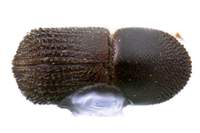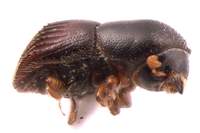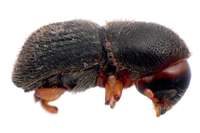Diagnosis
Small to medium size, mostly black, rugose appearance. Elytral declivity with numerous tubercles and asperities transformed into ridges and furrows, or dense and scattered. Protibia narrow, curved, inflated posteriad and with rugosities or tubercels on posterior side. Antennal club broad, scapus short and stout.
Distribution
South Asia and Oceania.
Biology
Some SE Asian species seem to be specialized on Dipterocarpaceae, while others, for example New Guinean species, are generalists. Gallery in the form of a short tunnel ending in a large brood cavity.
Taxonomy
Probably related to Truncaudum. In older literature mistakenly included in tribe Webbini, but it is not related to Webbia.
Detailed description
Eyes shallowly or deeply emarginate, sometimes almost disjunct, upper part of eye smaller than lower part, or as large as lower part. Antennal club approximately circular, or broader than tall and asymmetrical. Antennal club type two (obliquely truncated, segment 2 visible on posterior side). Segment 1 covering most or all of posterior face, its margin completely costate. Segment 2 narrow, pubescent, visible on anterior side only, or visible on both sides; if segment 2 has a corneous part, that is visible only on anterior side. Segment 3 absent from posterior side. Segment 1 of antennal funicle shorter than pedicel, funicle 4-segmented, scapus regularly thick or distinctly thick and short. Frons above epistoma mostly smooth, alutaceous, with minor punctures, or rugged, coarsely punctate. Submentum deeply impressed, shaped as very narrow triangle. Anterior edge of pronotum with no conspicuous row of serrations (serrations don't differ from those on pronotal slope), or with distinct row of serrations. Pronotum from lateral view elongated, with low summit (type 7), rarely basic shape (type 0). From dorsal view it is short, parallel-sided, rounded frontally (type 2), or conical on anterior part (type 6), or elongated basic shape with rounded frontal margin (type 7). Pronotal disc densely and evenly punctured, or with dense setae, lateral edge of pronotum obliquely costate. Procoxae contiguous, prosternal posterocoxal process short and conical, or flat and inconspicuous. Tuft of setae on pronotal basis associated with mesonotal mycangium absent, or similar tuft present but does not indicate mesonotal mycangium; setae on elytral bases associated with elytral mycangium also absent. Scutellum flat, flush with elytra, or regular size, impressed medially. Elytral bases straight, with oblique edge, or with slightly curved margin, mycangium probably absent. Elytral disc longer than declivity, flat, or slightly convex or inflated, punctures on elytral disc in strial lines (which may be difficult to discern), or confused. Boundary between elytral disc and declivity distinct. Lateral profile of elytral declivity usually flat, rarely convex, or truncated, in some species with teeth or ridges on edge. Dorsal profile of elytral apex rounded or angulate. Elytral declivity vestiture variable, sparse setae or scales to dense cover of setae more abundant than strial punctures. Posterolateral declivital costa absent or indefinable, or ending in 7th interstriae. Inner part of declivity has no tubercles, or has uniform granules, or tubercles present on elevated sulcus around declivity, or tubercles abundant. Striae and interstriae on upper part of declivity either entirely confused and covered with rugose tubercles, or form ridges and furrows. First interstriae parallel, or parallel on disc but broadened towards apex of elytra. Protibiae very slender, slightly broader only at distal end. Posterior side of protibia inflated, often with several granules, rarely flat. Protibial denticles small, usually between 6 and 8 present, bases of denticles small, slightly elevated. Uniformly dark brown or black. Length 1.2-3.2 mm.



